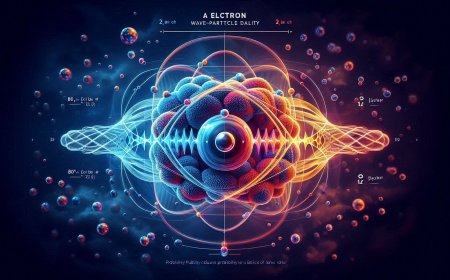Nuclear Model of the Atom: A Revolutionary Leap in Chemistry
Explore Rutherford's nuclear model of the atom, which revolutionized atomic theory by introducing a dense nucleus at the center of the atom, surrounded by orbiting electrons. Learn about its significance in modern chemistry.

The journey to understanding atomic structure has been long and filled with remarkable discoveries, but one of the most pivotal moments came with the proposal of the nuclear model of the atom. This model, introduced by Ernest Rutherford in 1911, fundamentally changed our understanding of atomic structure and laid the groundwork for modern atomic theory.
The Road to Discovery: Background of Atomic Models
Before Rutherford's groundbreaking work, scientists had a very different view of atomic structure. In 1897, J.J. Thomson discovered the electron, a subatomic particle with a negative charge. Based on this, Thomson proposed the "plum pudding model," envisioning the atom as a positively charged sphere with electrons embedded within it, like raisins in a pudding. While this model accounted for some properties of the atom, it was incomplete and could not explain the results of certain experiments.
In 1909, Rutherford and his colleagues, Hans Geiger and Ernest Marsden, conducted an experiment that would revolutionize atomic theory. In what is now famously known as the gold foil experiment, they bombarded a thin sheet of gold foil with alpha particles (positively charged particles). Most particles passed straight through, but some were deflected at large angles, and a few even bounced back, indicating the presence of a dense, positively charged region within the atom.
The Birth of the Nuclear Model
Rutherford proposed a new model to explain these surprising results. In the nuclear model, he suggested that the atom consists of a small, dense nucleus at its center, where most of the atom’s mass and positive charge are concentrated. The nucleus is surrounded by electrons, which orbit the nucleus much like planets orbiting the sun. This new model addressed the flaws in the plum pudding model by explaining why most alpha particles passed through the foil while a few deflected, as they encountered the dense, positively charged nucleus.
Rutherford's model introduced two major concepts:
- The Nucleus: The atom's positive charge and most of its mass are concentrated in a tiny nucleus at the atom's center.
- Empty Space: Most of the atom is empty space, with electrons orbiting the nucleus at a relatively large distance.
Impact and Implications of the Nuclear Model
The nuclear model was a monumental breakthrough, marking the beginning of a new era in atomic physics. It paved the way for the discovery of protons, neutrons, and the development of quantum mechanics, which would eventually refine our understanding of atomic structure even further.
Niels Bohr, inspired by Rutherford’s model, proposed an improvement in 1913, suggesting that electrons travel in fixed orbits, or "shells," around the nucleus, which became known as the Bohr model. Later advancements by quantum mechanics allowed scientists to describe electron behaviors and locations more accurately using probability distributions, leading to the modern quantum model.
Modern Applications and Legacy
The nuclear model of the atom remains one of the cornerstones of atomic theory. Understanding atomic structure has allowed scientists to make incredible advances in fields ranging from chemistry to nuclear energy and medicine. Innovations in X-ray technology, radiation therapy, nuclear power, and even particle physics owe a debt to Rutherford's atomic model.
Conclusion: The Lasting Legacy of Rutherford’s Nuclear Model
Rutherford’s nuclear model of the atom was revolutionary, providing a clearer view of atomic structure and transforming scientific thought in ways that continue to shape our world today. From classroom chemistry to advanced nuclear research, the nuclear model of the atom remains an enduring testament to the power of scientific curiosity and experimentation in uncovering the mysteries of nature.
What's Your Reaction?




























